Entertainment
Upheaval wrestles with tradition in Korean art of the 1960s and ’70s at the Hammer Museum

Seoul is the latest major city to establish itself as a significant international hub for new art. With that distinction comes the expected propagation of ambitious museum exhibitions seeking to articulate, illuminate and cogitate over its local history of modern art, which is little known.
“Only the Young: Experimental Art in Korea, 1960s-1970s” is the latest. It follows “The Space Between: The Modern in Korean Art,” which a year ago covered 1897 to 1965 at the Los Angeles County Museum of Art.
“Only the Young,” organized last year by the Solomon R. Guggenheim Museum in New York, working with Korea’s National Museum of Modern and Contemporary Art, is at the UCLA Hammer Museum in Westwood through May 12. It’s the first show of its kind in North America. With 29 artists and nine artist groups, the exhibition is anchored by varieties of Conceptual art, which became the leading form internationally in the decades under review. The result is work that feels at once recognizable and unfamiliar, which sometimes makes for a bit of a tough haul, if also a nicely curious experience.
The history of the participating Korean museum suggests some of what you’ll find explored in the show. The institution, founded in 1969, smack in the middle of the exhibition timeline, has now branched out into four satellites — Gwacheon, Deoksugung, Cheongju and Seoul, most of them in and around the nation’s capital. Those sites represent shifting centers of power, influence and reigning cultural philosophy within the country, beginning with the isolationist Joseon dynasty that ruled for half a millennium, before the tumultuous modern era.
Of the 29 artists, all but two, Jung Kangja and Lee Hyangmi, are men. That’s one indication of the deep social conservatism of an era of rebuilding after the Korean War, which was led by strongman Park Chung Hee. His tenure — Park took power in a 1961 military coup and was assassinated while still in office in 1979 — brackets the show’s “experimental” era.
A timeline of Korean performance art leads to Song Burnsoo’s “Take Cover I-V,” five silkscreen images.
(Christopher Knight / Los Angeles Times)
Jung’s participation in a satirical 1968 performance stands out. In a happening that parodied academic female nudes painted by men, her male colleagues, Chung Chanseung and Kang Kukjin, attached transparent balloons to her semi-naked body. The balloons then were popped, one by one, to fully expose the 26-year-old artist.
A hit with their avant-garde coterie, partly for its virtually unprecedented feminist insistence on a living, breathing woman’s centrality to the project, the event didn’t go down well everywhere, including in a scandalized Korean popular press. (Police were also on hand to observe.) Two years later, annoyed authorities shuttered a survey exhibition of Jung’s work.
Jung, Chung and Kang had all been students in the department of Western painting at Seoul’s Hongik University. That such a department existed shows where certain official Asian ambitions lay: The Western establishment was the standard for what “modern” meant. Many young Korean artists worked in groups, affiliated formally or loosely, which may suggest just how minimized experimentation was. (There’s strength in numbers.) Amid churning local political controversies around national identity, the students surely were looking to developments in Europe and the United States for artistic inspiration, with contemporary art magazines as a guide.
At the Hammer, “Transparent Balloons and Nude” is represented by a slightly blurry photograph, displayed with other still and video images of performance art in a helpful timeline that spreads across a wall. The performance indicates obvious debts to slightly earlier Western works.
Among them are Yves Klein’s 1960 performance in Paris, “Anthropometry of the Blue Period,” in which nude women were slathered in blue paint and then imprinted their bodies on canvas; and Yoko Ono’s 1964 “Cut Piece,” first performed in Tokyo and then London and New York (at Carnegie Hall, no less), where she sat alone on a stage while members of the audience were invited to come up and cut off pieces of her clothing. Neither of these cutting-edge Western precedents required police to be in attendance, which yields dramatic — and courageous — resonance for the Koreans’ performance.
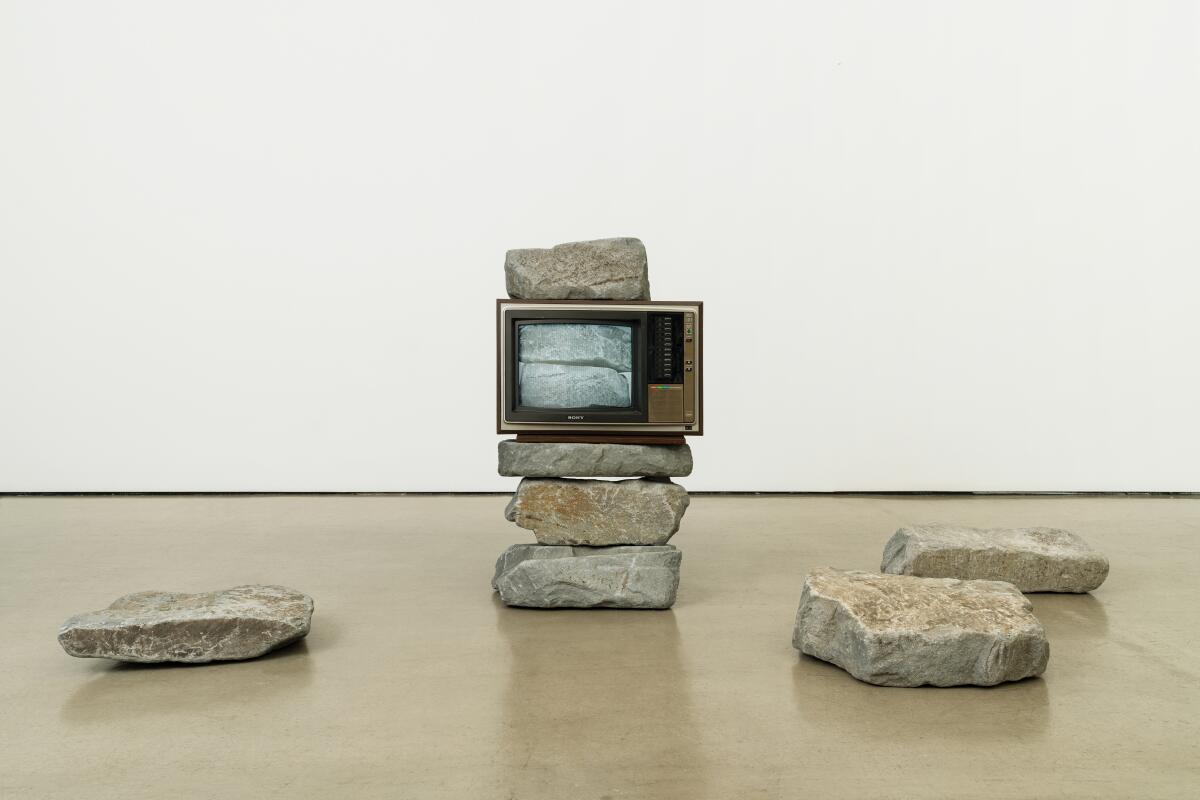
Park Hyunki, “Untitled (TV Stone Tower),” 1982, mixed media.
(Hammer Museum)
L.A. is home to the largest Korean diaspora, but the country’s history, which may or may not be familiar to Hammer visitors, illuminates what artists were up to. It was not always to profound effect. For instance, Andy Warhol is an obvious marker for Song Burnsoo’s “Take Cover I-V,” five silkscreen images that repeat a gas-masked face, its sequence of solid colors representing coded government alarms related to threats from North Korea. The work’s Pop social commentary is pretty thin.
More intriguing is Park Hyunki’s “Untitled (TV Stone Tower),” which inserts a television monitor within a short stack of hefty stones, surrounded by additional scattered rocks. (Here the show fudges a bit, since the work is dated 1982.) In this Brancusi-inflected “endless column,” commercially produced and ephemeral mass imagery is juxtaposed with an actual, if abbreviated, mass drawn from nature, creating an oddly poignant sense of loss. The effect is only enhanced by learning from the show’s excellent catalog that Park’s composition refers to traditional Korean doltap, stone piles erected at temples to drive away evil spirits.
Two of the show’s simplest works are among its most hauntingly beautiful. Lee Seung-taek’s “Tied Ceramic” and Ha Chong-Hyun’s “Work 73-13” both date from the early 1970s, a time of serious national distress that included ramifications from participation in the Vietnam War.
“Tied Ceramic” leaves the tracks of a rope that, before firing in a kiln, were wound around a white porcelain moon jar, an exquisite traditional form highly revered during the premodern Joseon dynasty. The wrapping marks, cut into the clay like a memory made concrete, oscillate between signs of painful bondage and a warm embrace, a tension both social and artistic in 1970s Korean culture.
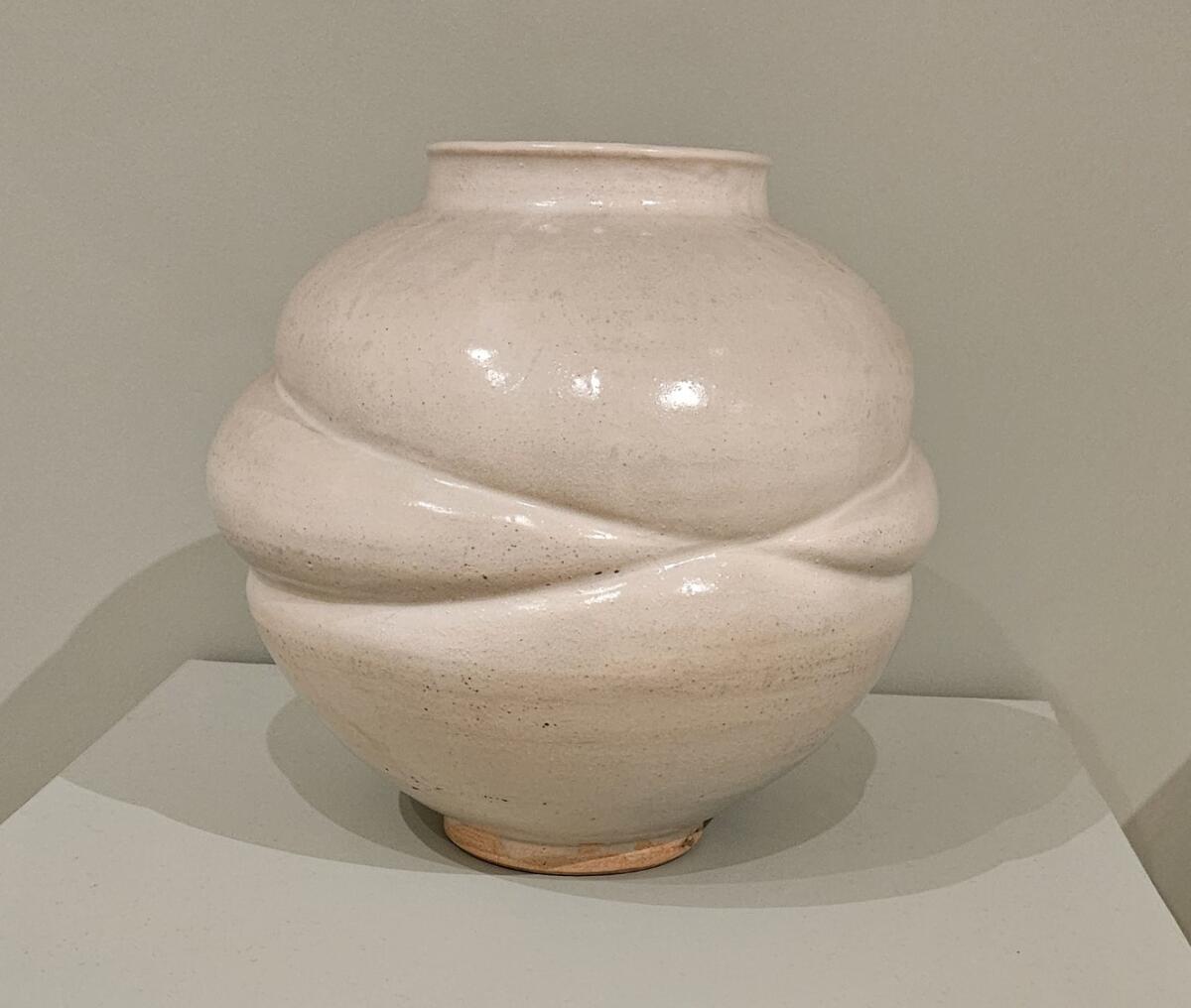
Lee Seung-taek, “Tied Ceramic,” 1975, porcelain.
(Christopher Knight / Los Angeles Times)
“Work 73-13” is a large, earthy, monochrome abstraction, its mottled muddy color achieved by pushing brown oil paint through rough jute from behind. Almost 4 feet tall and nearly 8 feet wide, the plane is wrapped in a strict grid of barbed wire. The aesthetic effect is of nature, tradition, human effort and modernity imprisoned but unstoppable. It will all ooze out.
A kind of exclamation point marks the final room, where a tall, severed tree stump rises from a big, precisely carved cube made of soil, gravel and concrete. Lee Kun-Yong’s sculpture “Corporal Term,” which sits atop a wooden pallet, is remade whenever it is shown, its natural elements scavenged from local sources. (A Hammer label is careful to note that this particular tangled stump was found as is; no trees were harmed to make the art.) The title “Corporal Term” describes the bodily lifespan of the sculpture, the human effort to fabricate the form, the viewer’s experience of it — even, perhaps, the long arc of Korean history that has brought the object here. The work is a lovely meditation on mortality and endurance.
Kim Kulim, who worked in Los Angeles in the 1990s, emerges from “Only the Young” as an essential artist for the experimental activity that erupted in 1960s Korea. At the show’s entrance, his painting “Death of the Sun II” (1964) is a scarred, all-black panel, made from paint covered with a petroleum-doused vinyl sheet that was set on fire and then smothered. The battered panel — painting as performance art — takes a cue from Shōzō Shimamoto, Saburō Murakami and other Gutai aesthetics of 1950s Japan, which emerged from the apocalyptic ruins of Hiroshima and Nagasaki.
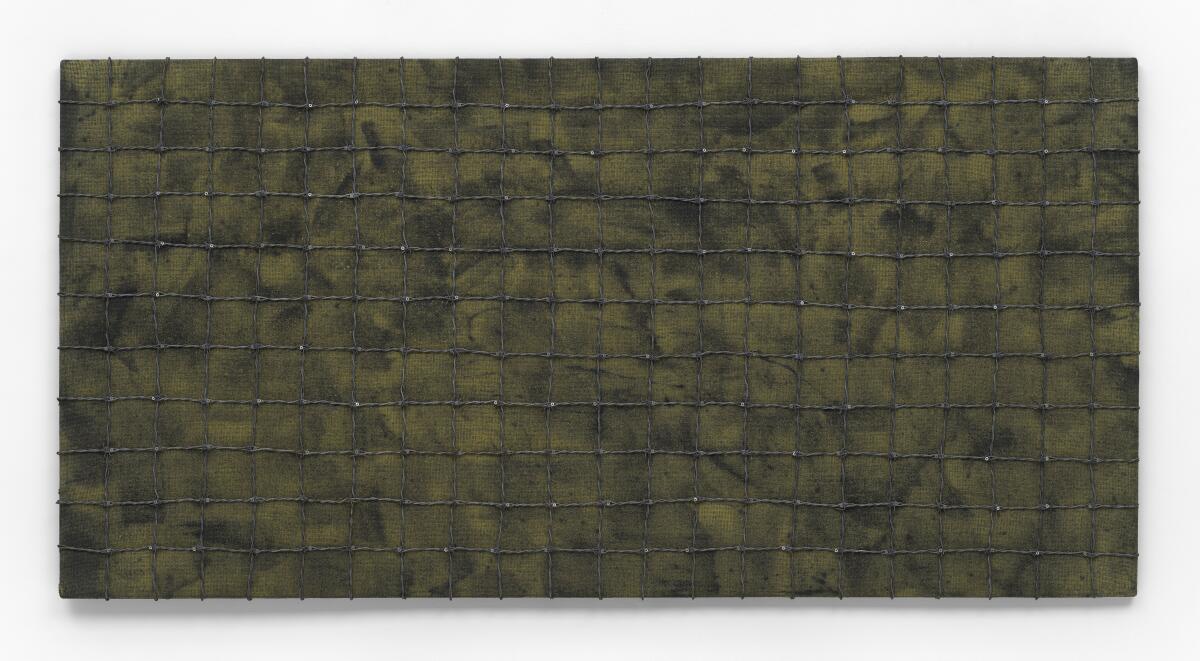
Ha Chong-Hyun, “Work 73-13,” 1973, mixed media.
(Ariel Ione Williams)
“Death of the Sun II” metaphorically destroys both the revered Korean tradition of black ink painting and modern Western abstraction, whose epitome was said to be the structural void represented by the all-black paintings of 1950s American artists Robert Rauschenberg, Ad Reinhardt, Mark Rothko and Frank Stella. As the show unfolds, Kim turns up in several disparate guises — making films, producing happenings, wiring a big electrified panel of dancing lights — leaving one to wonder what a full solo retrospective might reveal.
Conceptual art was both an extension and a critique of modernism. A common though mistaken assumption is that varieties of Conceptual art erupted in New York and eventually spread out to cover the art globe, as Abstract Expressionist, Pop, Minimal and street art are often erroneously claimed to have done. Rather than representing a cultural center and its periphery, however, the artistic shift in the 20th century’s second half had multiple points of origin all over the globe. Seoul and its environs formed one of them. “Only the Young” does an admirable job of presenting the Korean dialect of Conceptual art’s emergent international language.
‘Only the Young: Experimental Art in Korea, 1960s-1970s’
Where: UCLA Hammer Museum, 10899 Wilshire Blvd., Westwood
When: Through May 12. 11 a.m. to 6 p.m. Tuesdays to Sundays, 11 a.m. to 8 p.m. Fridays; closed Mondays
Admission: Free
Info: hammer.ucla.edu, (310) 443-7000

Movie Reviews
What If Jessica Chastain and Anne Hathaway Had a Mother-Off, and We All Lost?
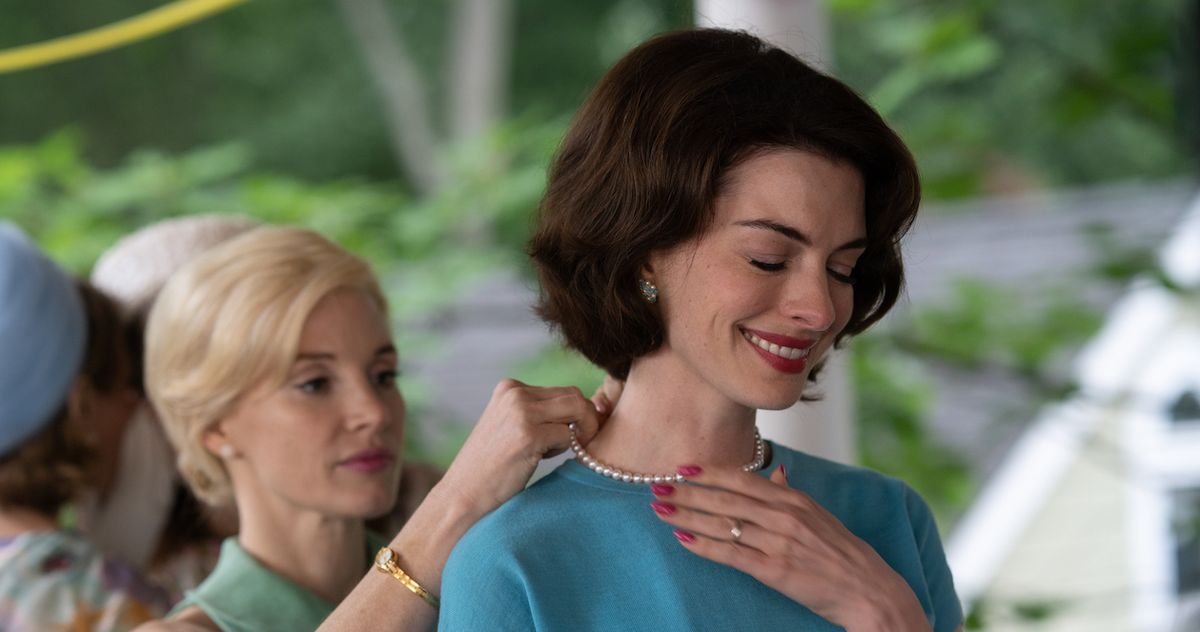
The strange case of Mothers’ Instinct.
Photo: Neon
There’s a new movie starring Jessica Chastain and Anne Hathaway out this week, which is normally the sort of thing you’d expect to have heard about. But, after its release in the U.K. months ago, Mothers’ Instinct is slipping into U.S. theaters with as little splash as an Olympic diver nailing a triple somersault tuck. The film, a thriller directed by Benoît Delhomme, is getting the treatment typically reserved for a disaster, which is a shame, because I’ve been dying to discuss it with someone, and that’s hard when no one has any idea what you’re on about. Mothers’ Instinct is, indeed, pretty terrible, and not in the so-bad-it’s-good sense, and yet there’s something strangely moving about it. It’s a poignant example of how what looks like rich material to actors can turn out to be lousy material for audiences. Mothers’ Instinct is a remake of a 2018 Belgian film adapted from a novel by Barbara Abel, and watching it, you can appreciate exactly why these two major actors signed on to star in it. Funnily enough, those same qualities go a long way toward explaining why the movie doesn’t work.
Mothers’ Instinct isn’t camp, but it’s close enough that if you squint, you can almost see a version of the film that tips into something broader. Of course, if you squint, you wouldn’t be able to appreciate how immaculately Chastain and Hathaway are costumed. They look incredible — not like two 1960s housewives, which is what they’re playing, so much as two people who keep switching outfits because they can’t decide what to wear to the high-end Mad Men–themed party they’re headed to later. As Alice, Chastain is styled like a Hitchcock blonde in pin-curled ash updos and cardigan sets, while as Alice’s neighbor and friend Céline, Hathaway is given a Jackie O. look that involves a shoulder-length bouffant, pillbox hats, and gloves. They’re cosplayers in a gorgeous, airless setting, adjoining houses on a street that might as well be floating in space, the husbands (played by Anders Danielsen Lie and Josh Charles) vanishing to work for long stretches. The artificiality of this intensely manicured re-creation isn’t to any particular end, which gives the whole movie the air of a Don’t Worry Darling situation in which no one ever wakes up to the twist, instead sleepwalking through a stylized dream of Americana.
In fact, while Alice is restless over having given up her job as a journalist to take care of her son Theo (Eamon O’Connell), and Céline gets ostracized by the community after the death of her son, Max (Baylen D. Bielitz), Mothers’ Instinct isn’t actually all that interested in the pressures of living under a repressive 1960s patriarchy. Instead, it’s about another time-tested theme, one that’s best summed up as: Bitches be crazy. The perfect sheen of its surfaces — Delhomme, who’s making his directorial debut, is a cinematographer who started his career with The Scent of Green Papaya and has since worked with everyone from Tsai Ming-liang to Anton Corbijn — is paired with a score that shrieks unease from the opening scene, in which Céline is thrown a surprise birthday party. The source of this suspense isn’t revealed until later, after Max takes an unintended swan dive off the porch and the women’s friendship is threatened by grief, guilt, and suspicion. Is Céline in mourning, or does she actually irrationally blame Alice for what happened while developing an alarming fixation on Theo? Is Alice right to be suspicious of her bestie, who’s unable to have another baby, or is she being paranoid because the mental illness that previously resulted in her hospitalization has returned? Is it odd that two feminist actors jumped to participate in a film that traffics so freely in unexamined stereotypes about women and hysteria?
Not, it seems, when the opportunities to stare coldly into space or look on in glassy betrayal are this good. I’m not trying to sound snide here — the characters in Mothers’ Instinct have no convincing inner lives at all, but the exterior work of the actors playing them is choice stuff. When Alice and Céline are getting along, Chastain and Hathaway nuzzle together supportively like long-necked swans. When things start to go south, Chastain opts for an aloof distance with stricken eyes, while Hathaway prefers a labored smile that drops as soon as she’s alone. Theirs is a brittle-off no one can win, but both try their hardest anyway. The effort reaches its crescendo at Max’s funeral, where Hathaway’s enormous eyes glimmer through the barrier of a black lace veil and Chastain tilts her face up so that the elegant tracks of past tears can gleam in the light. The scene ends with Céline collapsing in anguish while Alice rushes her tantrumming child out of the church, an explosion of drama that would be so much more effective if the movie had left any room for modulation instead of starting at 10 and staying there. Mothers’ Instinct gets much sillier before it ends, but given how little it establishes as its baseline tone, it doesn’t feel fair to say it goes off the rails. Rather, as Hathaway stares brokenly into the dark and Chastain tears apart her nightstand drawer in panic, what comes to mind is how great a set of GIFs this movie will make someday. That’s not much, but I guess it’s something?
See All
Entertainment
Tyler Perry calls out 'highbrow' critics, defends his fans: 'Don't discount these people'
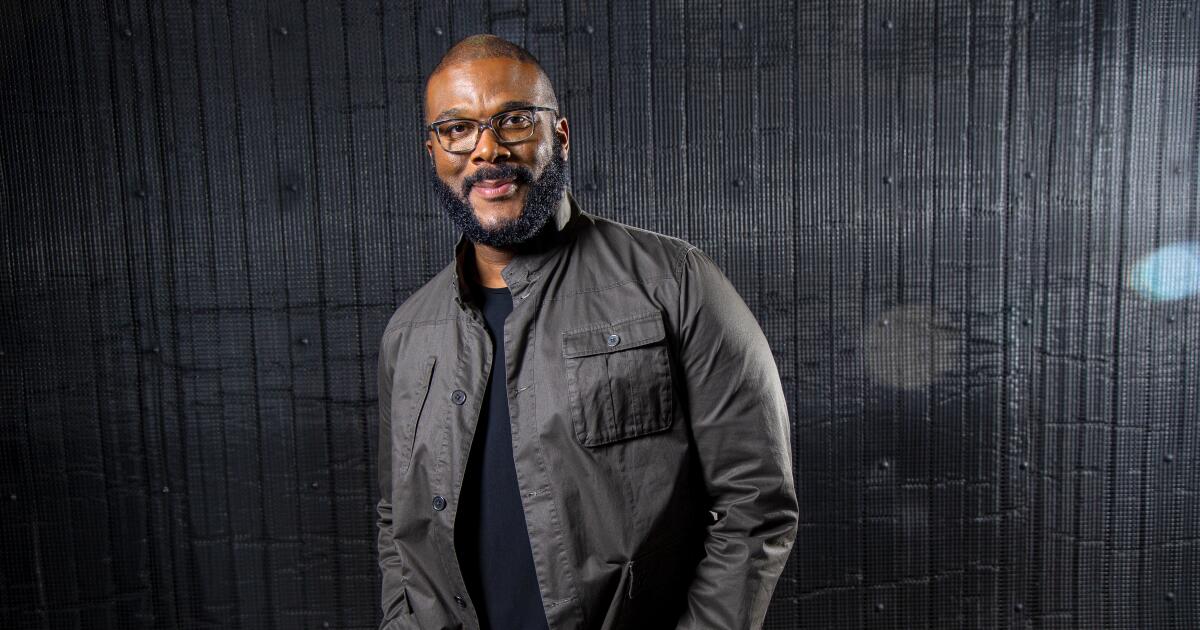
Tyler Perry’s last feature film earned a rare 0% on Rotten Tomatoes — a point that’s apparently of little concern to him.
The billionaire filmmaker, best known for his franchise character Madea, is far more interested in the opinions of his fans than those of “highbrow” critics, he said on the “Baby, This is Keke Palmer” podcast.
“For everyone who is a critic,” Perry said in the Tuesday episode, “I have thousands of — used to be — emails from people saying: ‘This changed my life. Oh, my God, you know me. Oh, my God, you saw me. How did you know this about my life and my family?’ So that is what is important.”
Critiques of Perry and his purportedly flat depictions of Black characters date back to his early directing days. Spike Lee, for one, in 2009 famously alluded to Perry’s work while complaining about the “buffoonery” in Black comedy. More recently, playwright Michael R. Jackson took his turn swinging at the movie mogul in his metafictional musical “A Strange Loop.”
In the number “Tyler Perry Writes Real Life,” Jackson’s protagonist — a Broadway usher who dreams of being a writer — denounces Perry’s oeuvre: “The crap he puts on stage, film and TV / Makes my bile want to rise!”
The song wasn’t born of any “personal vendetta,” Jackson told Washington Post Live in 2022. “It’s really about actually taking Tyler Perry’s work very seriously, because it’s often held up, often by Black communities, as sort of, like, the end-all-be-all of what one can do as a Black artist.”
“I just wanted to sort of problematize that and satirize that,” he said.
Upon Palmer referencing Jackson’s musical jab, Perry told the podcast host, “I know for a fact that what I’m doing is exactly what I’m supposed to be doing.”
When it comes to critics in general, he continued, it’s best to “drown all that out.”
“We’re talking [about] a large portion of my fans who are disenfranchised, who cannot get in the Volvo and go to therapy on the weekend,” he said. “So you’ve got this [Black critic] who is all up in the air with his nose up looking at everything, and then you’ve got people like where I come from, and me, who are grinders, who really know what it’s like, whose mothers were caregivers for white kids, and were maids and housekeepers.”
He added: “Don’t discount these people and say that their stories don’t matter. Who are you to be able to say which Black story is important or should be told? Get out of here with that bull-.”
Corey Hardict, who co-stars in Perry’s latest film “Divorce in the Black,” last week invoked a similar defense for the critical bomb: “I mean, the people love the movie and we do it for the people — that’s who I do it for. If the culture’s rocking with it, it’s all love. So it’s fine.”
Perry’s podcast comments have already garnered backlash online, with Preston Mitchum of the reality show “Summer House: Martha’s Vineyard” writing Wednesday on X, “Yes, because writing and producing a movie where a Black woman from a small town cheated on her husband, acquired HIV, then ended up physically disabled is absolutely the groundbreaking Black story we need to see.”
Mitchum’s post seemingly refers to Perry’s 2013 film, “Temptation: Confessions of a Marriage Counselor.”
Palmer defended Perry against other disparagers online, writing Wednesday on X, “The enemy isn’t Tyler it’s the system that makes it hard for multiple black artist[s] to shine at one time.”
“Tyler is not the gatekeeper of all black stories he’s just one creative who broke through the system,” she wrote. “Advocating for others to do the same is the fight, not hating Tyler for his work that many do love.”
Perry in 2019 celebrated the grand opening of his 330-acre Tyler Perry Studios in Atlanta. He created the complex with the hope of promoting cultural diversity in the film industry, he told The Times in 2016.
“Sometimes I drive around here by myself and think, ‘Is this too much, or is this what I’m supposed to do?’ ” Perry said. “The answer is obvious. When this fell into my lap, I said, ‘I have to do this.’ This is the endgame.”
Movie Reviews
Movie Review: Twisters – Kenbridge Victoria Dispatch

Movie Review: Twisters
Published 11:15 am Friday, July 26, 2024
1 of 3
Let me immediately cut to the chase (pun intended) and answer the question you’re all wondering. TWISTERS is a fun and entertaining summer blockbuster, but it in no way holds a candle to its predecessor TWISTER (1996). Still, the CGI is intense, the sound design is loud and immersive, and the lead performances — especially from Glen Powell — are sure to wow.
Following a horrible tragedy, meteorologist Kate Carter (Daisy Edgar-Jones) has spent years out of the storm chasing business. She now lives in the largely tornado-less New York City, using her innate understanding of storm systems to direct weather alerts. But when her old friend Javi (Anthony Ramos) begs her to join his privately-funded start-up, which is designed to use military-grade radars to learn more about tornadoes and save communities in Oklahoma, she agrees to give him a week of her time. It’s not too long before “tornado wrangler” influencer Tyler Owens (Glen Powell) enters the scene with his ragtag group of weather enthusiasts, creating a competition between scientific research and entertainment. Each group races to be the first on the scene, with Kate and Javi seeking to model the tornado and Tyler trying to get the most likes on social media. But can the two groups find a way to work together or will the competition be more vicious than the tornadoes?
I am admittedly judging myself for caring too much about a summer blockbuster’s plot, because that’s not really what any of us sign up for with these films. But the various encounters with tornadoes begins to feel slightly repetitive and creates pacing issues, making a two-hour film feel like its runtime. And for some reason, it seems like there is something missing when it comes to portraying the sheer terror of experiencing F5 tornadoes, unlike the original film; the main set pieces were not as memorable.
The film does little to make you care about whether the characters live or die, relying on Glen Powell and Daisy Edgar-Jones’s chemistry and natural charisma to do the heavy lifting. The second Powell steps out of his gigantic truck, with his cowboy hat and belt buckle sparkling in the sun… sorry, I just lost my train of thought… and that’s what TWISTERS is hoping. Powell’s magnetism is sure to knock you off your feet and distract you from the film’s middling plot. And while Edgar-Jones’s performance is more muted, due to her character’s battle with PTSD, she brings an important level of humanity to the film and a character to both see yourself in and root for. More than that, her chemistry with Powell is off the charts and will certainly leave you wanting their relationship explored more in a sequel. The supporting characters are not given much to work with and as such, don’t really engender much concern when they are in deadly situations.
One element of TWISTERS I liked more than TWISTER is it showed the emotional and financial toll tornadoes ravage on communities. Of course, that is an element of the first film, but TWISTERS does a great job showcasing the speed in which tornadoes can overtake and devastate a community, both in loss of life and loss of property. This, juxtaposed with the “fun” in chasing storms brings a real human element to the film. I also want to give a shoutout to the movie not having any sad animal scenes (apart from a possible run-in with a chicken). So for all of you sickos excited to see another flying cow, this isn’t for you.
TWISTERS is the exact kind of movie you need to see in a theater so you can get the full experience. Where else can you admire the cinematography, get immersed in the sound design, and lose yourself in Glen Powell’s cowboy hat and million dollar smile? I saw it in a Dolby theater and was blown away.
There is no end credit scene.
My Review: B
-

 World1 week ago
World1 week agoOne dead after car crashes into restaurant in Paris
-

 Midwest1 week ago
Midwest1 week agoMichigan rep posts video response to Stephen Colbert's joke about his RNC speech: 'Touché'
-

 News1 week ago
News1 week agoVideo: Young Republicans on Why Their Party Isn’t Reaching Gen Z (And What They Can Do About It)
-

 Movie Reviews1 week ago
Movie Reviews1 week agoMovie Review: A new generation drives into the storm in rousing ‘Twisters’
-

 News1 week ago
News1 week agoIn Milwaukee, Black Voters Struggle to Find a Home With Either Party
-

 Politics1 week ago
Politics1 week agoFox News Politics: The Call is Coming from Inside the House
-

 News1 week ago
News1 week agoVideo: J.D. Vance Accepts Vice-Presidential Nomination
-

 World1 week ago
World1 week agoTrump to take RNC stage for first speech since assassination attempt


















